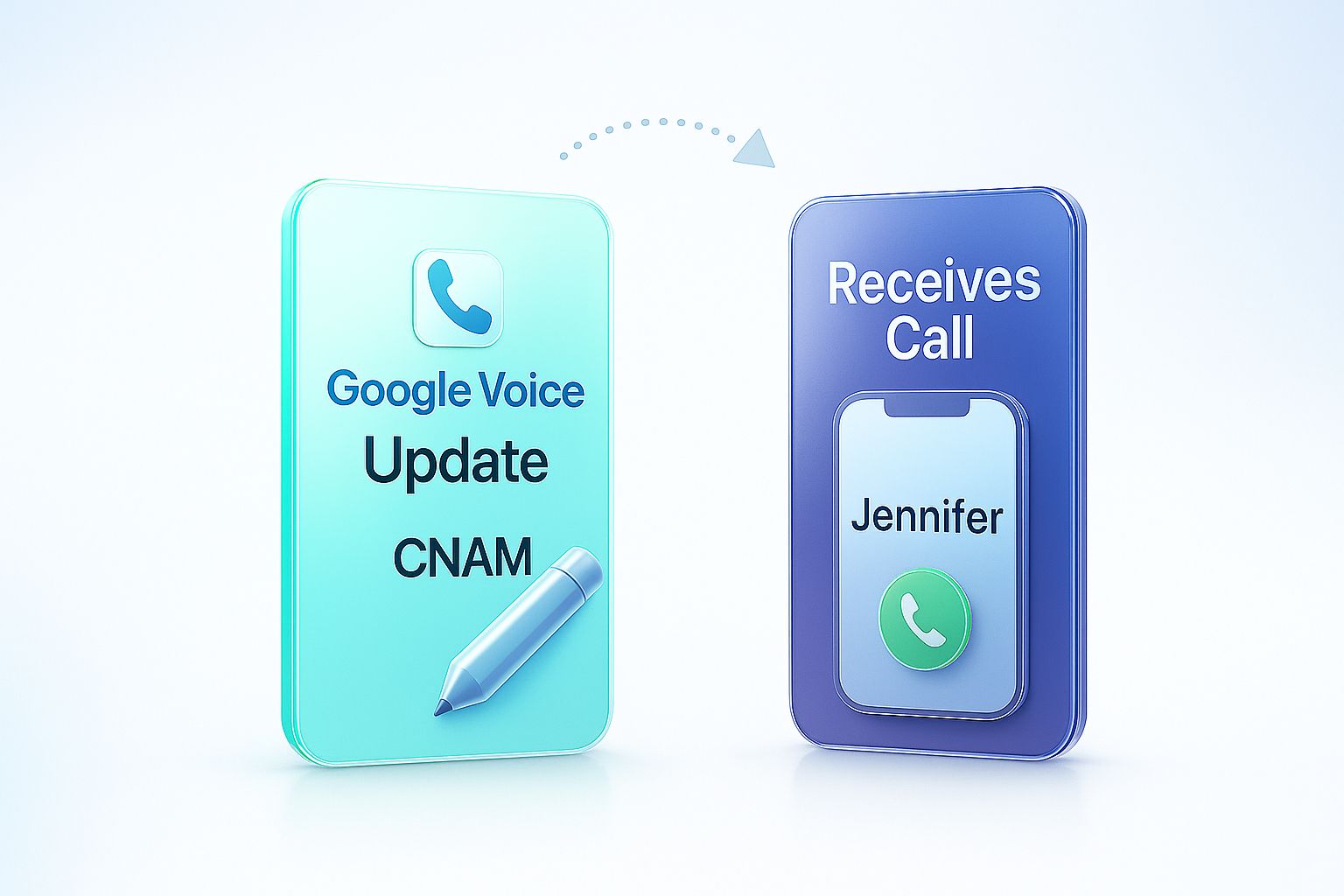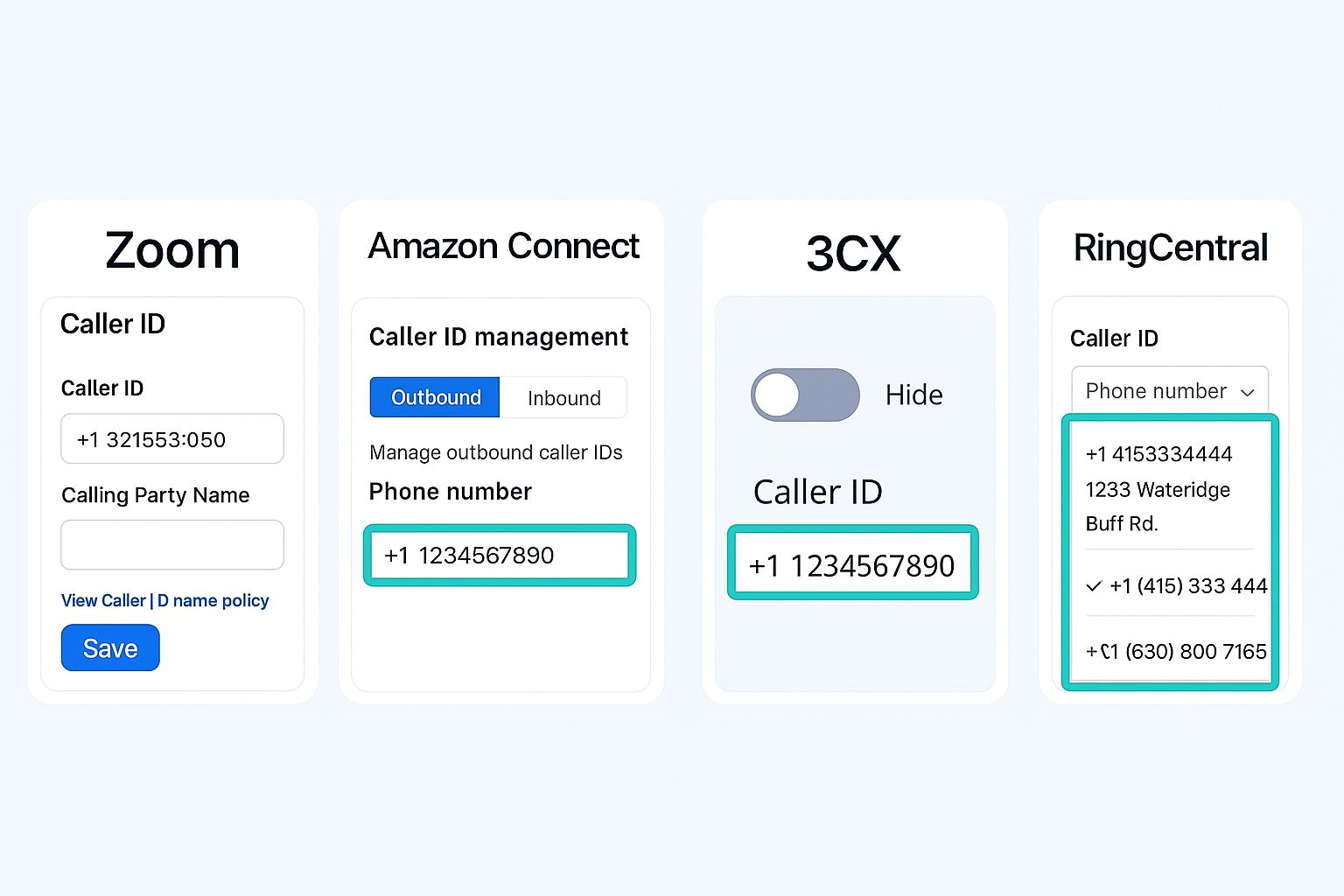Key Takeaway
- Standardize your caller ID everywhere. Set the number in E.164 format and the name (CNAM, ~15 chars) across Google Voice, Zoom, Amazon Connect, 3CX, FreePBX, RingCentral, and Android so every call shows the right identity.
- Update CNAM and get proper verification where required (STIR/SHAKEN). Propagation takes 24–72 hours, sometimes up to 7 days. Run the built-in 5-step test and recheck quarterly to avoid “Spam Likely.”
- Control who presents which number. Map IDs per user or queue, lock defaults, use overrides when needed, and test on multiple carriers to confirm what people actually see.
Caller ID types: what actually shows to the person you call
- Numeric Caller ID (CLI / E.164): the phone number that appears (or is used by networks). Always provide numbers in E.164 format (country code + number, e.g.,
+65 6123 4567) when configuring outbound settings. This is the primary technical identifier carriers use. - CNAM / Display Name: the text label that some networks show (company name, “Acme Support”, etc.). CNAM is separate from the numeric ID and is often managed via a CNAM registry or your carrier; in some countries CNAM is not used.
- STIR/SHAKEN & attestation: In the U.S. and some other markets, carriers use STIR/SHAKEN to cryptographically verify whether the calling number is likely legitimate. If your call lacks proper attestation, recipients may see “Not verified” or the call may be blocked. To maximize deliverability, work with your provider to ensure proper attestation and registration where required.
Why your outbound caller ID matters
When you place a call, your carrier sends the number first; downstream carriers then dip a national CNAM database to fetch the business name before the phone rings.
Because the name lookup happens at call time, a stale CNAM record can show an old company name or no name at all until you update it at the source and wait for propagation (anywhere from a few hours to a week).
Modern analytics apps also check STIR/SHAKEN attestation: if your number isn’t “signed” by the originating carrier, the call can be labelled “Spam Likely.”
What you need before changing settings
- A phone number you own (ported or purchased)
- Your desired 15 character CNAM text keep it legal name or DBA
- E.164 format handy (+1 555-123-4567) for PBX fields
- Admin access on the platform in question
make one number the “golden” outbound caller ID for all teams and standardise it inside your CRM so everyone dials with the same identity.
Google Voice
Google Voice displays whatever name the underlying carrier has on file; there is no in app toggle.
1. Confirm the correct number is assigned to your Google Voice account.
2. To update the CNAM, contact the carrier who provided the number or list yourself in the national database (many users use ListYourself.net).
3. Wait 24-72 hours; test by calling a mobile and landline.

Zoom Phone
Zoom lets admins and even more useful individual extensions pick from approved outbound IDs.
1. Admin Portal → Phone System Management → Company Info → Account Settings.
2. Enable Select Outbound Caller ID.
3. Under each user, choose the main company number or a DID.
4. Optional: tick Allow extensions to hide outbound caller ID when employees need privacy.
Tip: remind agents to double check their selection before dialing high value leads.
Amazon Connect
Queues define the caller ID in Amazon Connect.
1. Routing → Queues → select a queue → Outbound caller ID name/number.
2. Enter the business name (15 chars max) and the E.164 number.
3. Save; test from a contact flow set to that queue.
Because Amazon leases numbers from multiple carriers, CNAM updates can take up to seven days plan ahead for campaigns.
3CX & 3CX v20
The location of the field changed in v20, so check your version first.
Pre v20
1. SIP Trunks → pick trunk → Caller ID tab.
2. Enter the desired number or set a per extension override.
v20
1. Click Admin (bottom left) → Voice & Chat.
2. Open the trunk → Options → Caller ID Control.
3. Set global caller ID or map by outbound rule.
Always format numbers as +countrycode; some carriers reject domestic only formatting and drop the CNAM lookup.
FreePBX
FreePBX gives you granular control through the Outbound Routes module.
1. Connectivity → Outbound Routes → edit route → Route Settings.
2. In Route CID, type “Johns Bakery <+15551234567>”.
3. Tick Override Extension if you want the system to ignore whatever the handset sends.
4. Submit & Apply Config.
Users often forget the angle bracket syntax; copy the example exactly to avoid a rejected call.
RingCentral
RingCentral lets each user pick a default caller ID without needing admin help.
1. Settings → Phone → Default caller ID.
2. Choose any company number assigned to that user or your main line.
3. Save; mobile app updates instantly, desk phones after resync.
If you have many users, lock this field at the admin level so branding stays consistent.
Android (major US carriers)
Android phones rely on the carrier’s “Name ID” service:
- AT&T: myAT&T → Profile → Caller ID.
- T Mobile: T Life app → More → Caller ID.
- Verizon: My Verizon → Account → Share Name ID.
Changes can take up to 72 hours at AT&T and 24 hours at Verizon. Test by calling someone who hasn’t saved you in contacts.
Using external numbers in Zendesk
If you forward calls from Zendesk Talk, standardise one outbound number inside the console to avoid agents randomly exposing DIDs.
1. Admin → Talk → Lines.
2. Pick an external number, mark as default.
Zendesk cannot overwrite the CNAM field update that with the underlying carrier first.
Troubleshooting “showing wrong name”
1. CNAM hasn’t updated yet Most carriers push CNAM records to the national database twice a day; give it 48–72 hours.
2. Number flagged as spam Calls that fail STIR/SHAKEN attestation show up as “Spam Likely”; open a support ticket and request A level attestation.
3. Multiple PBX layers If your softphone sets one caller ID and the trunk overrides it, the trunk wins. Double check outbound rules in FreePBX or 3CX.
4. Using 67 or privacy codes Dialing *67 forces “Private” caller ID, overriding all settings. Verify no outbound dial patterns add *67 automatically.
Troubleshooting: quick checklist
1. Confirm E.164 format — Make sure the outbound CLI is sent as +<countrycode><number> (no spaces or parentheses) when your SIP trunk or API accepts it. Example: +6561234567.
2. Is the number provisioned/ported? — If the number is mid-port, outbound CNAM/CLI may not work until the port completes. Verify port status with both carriers.
3. CNAM registry update — If the numeric CLI is correct but the displayed name is wrong/missing, ask your carrier about CNAM submission or registration (note: CNAM is regional).
4. STIR/SHAKEN attestation — For U.S. traffic, confirm with your provider whether calls are being signed and what attestation level is used (A = full, B = partial, etc.). Unsigned calls may be labeled “Not verified.”
5. Carrier filtering / rate limits — If calls are being dropped or shown as “Private/Unknown,” contact the terminating carriers to check blocking rules and ensure your traffic profile isn’t flagged as spam.
5 step test plan (run this to validate a new outbound CID):
1. Send a single test call from the production trunk to a mobile on a major carrier (e.g., Singapore: Singtel/M1/StarHub; U.S.: AT&T/Verizon).
2. Record exactly what the recipient sees (number, name, any label like “Not verified”).
3. If wrong, check CLI format in your SIP headers or API request and fix to E.164. Retry.
4. If numeric CLI is correct but name is wrong, escalate to the CNAM provider/carrier for an update.
5. If calls are marked unverified or blocked, request STIR/SHAKEN attestation status and confirm porting and provisioning with carrier ops.

Verifying your work
1. Call a mobile on a different carrier and a landline.
2. Use a free CNAM caller ID lookup tool to confirm the public record.
3. Recheck every quarter; carriers sometimes purge inactive numbers and blank the CNAM.
Frequently asked questions
1. How long does a national caller ID database update take?
Typically 24–72 hours in the US, but some carriers quote up to seven days.
2. Can I get a free outbound caller ID?
Yes most VoIP numbers include it. Google Voice and Zoom supply the number free; CNAM registration may cost a small one time fee.
3. What if I need different brands on one PBX?
Use per extension or per queue caller ID settings in FreePBX, 3CX, or Amazon Connect, mapping brand numbers to sales teams.
4. Does STIR/SHAKEN work outside the US?
Not yet; Canada and parts of the EU are piloting it, but enforcement dates vary.
Conclusion
A clean outbound caller ID is one of the fastest ways to look professional on every call. Pick one authoritative number, update the CNAM, follow the platform steps above, and verify with a lookup tool. Keep a quarterly reminder to refresh records and you’ll stay off spam lists and top of mind with customers.
Give your brand the voice and caller ID it deserves


